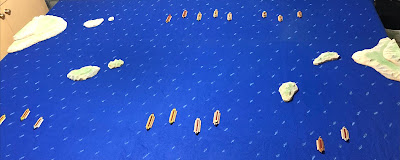The second game in this campaign turn (number 11) and has elements of an understrength South African Infantry Division defending a line of hills against a flanking attack by lead elements of the 15th Panzer Division.
The 15th Panzer order of battle:
- 2 x Armoured Car units
- 4 x Pz III units
- 1 x Pz IV unit
- 2 x Armoured Infantry units
- 1 x Marder Self-Propelled AT unit
- 1 x 88mm unit
- 1 x Wespe Mobile Artillery unit
South African Infantry order of battle:
- 1 x Armoured Infantry unit
- 2 x Infantry units
- 1 x 25 Pounder unit
- 1 x 6 Pounder unit
- 1 x 2 Pounder Portee unit
- 2 x Sherman tank units
- 2 x Matilda tank units
The above order of battle is after accounting for ongoing wear and tear from operating in the harsh desert conditions.
Plans
 |
| The tabletop setup. Allied forces are holding a defensive line along the hills, and have some tanks hidden behind the central escarpment. |
The 15th Panzer plans are to move along one of the tracks and seize the first objective of the central escarpment. A flanking force, about a third of the overall force, will attack their second objective the hills positioned in the centre.
 |
| The advance Panzer force arrives moving along one of the tracks. |
Opening Phase
The opening phase of the game had the 15th Panzer units quickly moving along tracks towards their first objective the central escapement. A short tank engagement was fought before the Allies retired to their defensive line along the hills. The 15th Panzer quickly pushed on to attach the Allied line, but after losses panzer forces retired and waited for their artillery and 88mm units to arrive.
 |
| A tank battle begins as Allies tanks attack the advancing Panzers. |
 |
| The Allied tanks retired to their defensive on the hills and waited. |
 |
| The 15th Panzer attack pushes on to the Allies defensive line with losses on both sides occurring, but the defence holds and the attack was called off until support units arrive. |
Flank Attack
As the panzers regrouped in the centre and brought up support units, their flanking units started to arrive. They ran into a unit of Matildas supported by a 6 pounder AT unit positioned on a hill. After a short engagement the flank attack was in disarray with the majority of units destroyed. This success allowed the Allies to reposition the Matildas, their only remaining tank unit, towards the centre where another attack was underway and beginning to make headway.
 |
| The flanking Panzers arrive just as the main attack has to regroup before making any further assaults. |
 |
| The combined attacks of the 6 Pounder AT unit and Matilda tanks eliminated the flanking threat. |
 |
| With the flank attack failing to achieve any success the main attack made another assault and with the support of the 88mm and artillery make a breakthrough. |
Final Phase
Having regrouped the 15th Panzer prepared to make a final attack with their remaining active units. The total failure of the flank attack meant this was going to be a make or break attack. The attack began well until the arrival of a unit of Matildas, which stopped the initial momentum. Accurate shooting from the 88mm unit put an end to this troublesome tank unit, and the attack momentum was back with the panzer units. The last Pz III unit with support from their artillery and 88mm were able to take the second objective.
 |
| The sole remaining Allied tank unit (Matildas) moves from the left flank to help defend the centre. |
 |
| The loss of their final tank unit had the Allies having to sit tight on the hills and prepare for the final attack from the depleted Panzer forces. |
 |
| A final attack proved successful and the 15th Panzer capture the 2nd objective and will the game. |
Game End
A victory to the 15th Panzer who ended capturing and holding two of the three objectives in the game. This is the second victory on this campaign turn and they will advance another zone, but with no more zones to retire too for the Allies the campaign is won by Axis forces.
 |
| The campaign ends with a second Axis victory. |
I will provide some comments on how the campaign rules went in a later post, and whether, or not, I settled upon the game rules by the end.













































